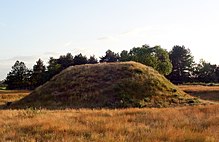
An Anglo-Saxon burial mound is an accumulation of earth and stones erected over a grave or crypt during the late sixth and seventh centuries AD in Anglo-Saxon England. These burial mounds are also known as barrows or tumuli.
Early Anglo-Saxon burial involved both inhumation and cremation, with burials then being deposited in cemeteries. At this time, the Anglo-Saxons adhered to a pagan religion, but as Christianity was introduced in the seventh century, it gradually became the dominant and eventually sole religion amongst the Anglo-Saxon kingdoms. Many of those buried in barrows were pagan, but others were instead Christian, and it is usually impossible for archaeologists to know which religion an individual belonged to.[1]
Earlier peoples living in Britain during the Neolithic and Bronze Ages had also constructed barrows for use as places of burial, something that was recognised by the Anglo-Saxon burial builders, who in many cases re-used these earlier barrows for their own uses.
- ^ Pollington 2008. pp. 53–54.